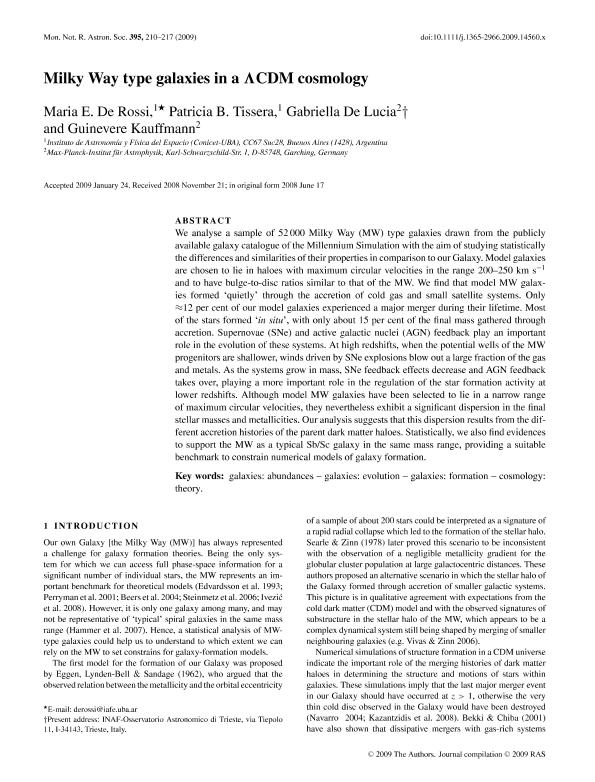Artículo
Milky Way type galaxies in a LCDM cosmology
Fecha de publicación:
05/2009
Editorial:
Oxford University Press
Revista:
Monthly Notices of the Royal Astronomical Society
ISSN:
0035-8711
Idioma:
Inglés
Tipo de recurso:
Artículo publicado
Clasificación temática:
Resumen
We analyse a sample of 52 000 Milky Way (MW) type galaxies drawn from the publicly available galaxy catalogue of the Millennium Simulation with the aim of studying statistically the differences and similarities of their properties in comparison to our Galaxy. Model galaxies are chosen to lie in haloes with maximum circular velocities in the range 200–250 km s−1 and to have bulge-to-disc ratios similar to that of the MW. We find that model MW galaxies formed ‘quietly’ through the accretion of cold gas and small satellite systems. Only ≈12 per cent of our model galaxies experienced a major merger during their lifetime. Most of the stars formed ‘in situ’, with only about 15 per cent of the final mass gathered through accretion. Supernovae (SNe) and active galactic nuclei (AGN) feedback play an important role in the evolution of these systems. At high redshifts, when the potential wells of the MW progenitors are shallower, winds driven by SNe explosions blow out a large fraction of the gas and metals. As the systems grow in mass, SNe feedback effects decrease and AGN feedback takes over, playing a more important role in the regulation of the star formation activity at lower redshifts. Although model MW galaxies have been selected to lie in a narrow range of maximum circular velocities, they nevertheless exhibit a significant dispersion in the final stellar masses and metallicities. Our analysis suggests that this dispersion results from the different accretion histories of the parent dark matter haloes. Statistically, we also find evidences to support the MW as a typical Sb/Sc galaxy in the same mass range, providing a suitable benchmark to constrain numerical models of galaxy formation.
Archivos asociados
Licencia
Identificadores
Colecciones
Articulos(IAFE)
Articulos de INST.DE ASTRONOMIA Y FISICA DEL ESPACIO(I)
Articulos de INST.DE ASTRONOMIA Y FISICA DEL ESPACIO(I)
Citación
de Rossi, Maria Emilia; Tissera, Patricia Beatriz; De Lucia, Gabriella; Kauffmann, Guinevere; Milky Way type galaxies in a LCDM cosmology; Oxford University Press; Monthly Notices of the Royal Astronomical Society; 395; 1; 5-2009; 210-217
Compartir
Altmétricas




